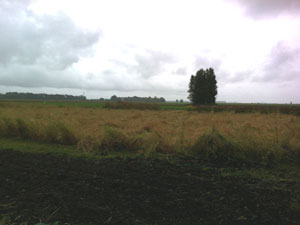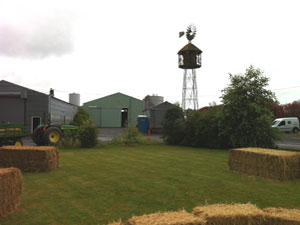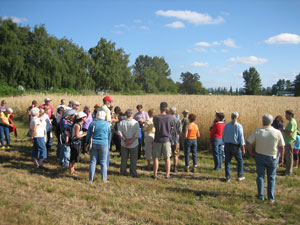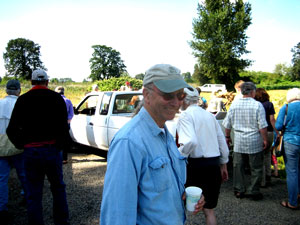
Home | Spaceship Earth | Book Reviews | Buy a Book | Bean and Grain Index | Short Stories | Contact | Mud Blog
THE SOUTHERN WILLAMETTE VALLEY
BEAN AND GRAIN PROJECT
Project Report Sixteen: Summer, 2012
By Dan Armstrong
The Southern Willamette Valley Bean and Grain Project is midway through its seventh growing season. Seven years ago the "big experiment," as Harry MacCormack refers to it, was really just test plots at Sunbow Farm.
In 2006, Harry learned from an article written by Chris Peterson of the Ten Rivers Foodweb that most of the bulk food items at First Alternative Coop in Corvallis, where he shopped, came from outside the state and in some cases from outside the country. Thinking about long-term food security and the importance of beans and grains in our diet, he bought sixteen samples of beans and grains at the coop and planted them at his farm. The results of those plots were surprisingly positive and inspired the work Harry has continued ever since–integrating staple crops into the mix of Willamette Valley agriculture.
A year later, following a talk he'd given on organic farming practices, Harry MacCormack met Willow Coberly, co-owner of Stalford Seed Farms, a 6000-acre grass seed farm. He told Willow about his experiments with beans and grains. She was immediately intrigued and planted twelve acres of hard red wheat that spring. Though this first trial produced only marginal results, Willow grew hard red wheat again in 2008 using seeds from her 2007 crop. She also began transitioning another 120 acres of her grass seed farm to organic, planting twenty acre plots of pinto beans, garbanzo beans, lentils, anasazi beans, and black beans plus smaller plots of flax and soybeans. This was the first year that the Bean and Grain Project was chronicled on the Mud City Press website. It was also the first year of growing for local sale.
The results of the 2008 growing season were mixed. There was a set back in the wheat. The lentils, anasazi, and soy beans did poorly. The black beans and pintos had some modest success, but the garbanzos yielded over 1000 pounds per acre and were actually a successful economic crop. In 2009, the grass seed market began to stutter and stall, and the concept of adding diversity to Oregon's main cash crop with beans and grains began to gather legs. More farms and farmers came to the table. The experimental base was widening.
Now, in the summer of 2012, there are more than twenty farms, big and small, conventional and organic, growing beans and grains in the south valley for sale in the local market. Two of these farms held tours this summer. One took place on June 30 in Tangent, Oregon at Stalford Seed Farms, and one took place on July 29 outside Eugene in Santa Clara at Lonesome Whistle Farm. The stories of these two tours and these two farms, one large and one small, provide a good look at what the Bean and Grain Project is today.


Stalford Seed Farms, Tangent, Oregon, June 30, 2012: Weather in the Willamette Valley is not particularly predictable, but the last four growing seasons have been remarkably similar. Spring has been cool and wet. May has shown the promise of summer with two or three weeks of sun and moderate temperatures, but June always seems to break that promise with more rain than we want and too many days where the temperature seems stuck below 60 degrees. July is the month when summer begins. The weather suddenly becomes dry as dirt and bright and sunny as a new dime, but this only lasts into the first or second week of September when the morning dew gets heavy, the probability of rain enters the forecast, and grains and beans better be out of the field.
This year followed that pattern. June 30, 2012 was not a pretty day in western Oregon. It was cool and heavily clouded. Light rain came and went throughout the day. In Tangent where the land stretches out flat in all directions and grass seed production has long been king, the gray clouds and intermittent rain were a reminder to the visitors arriving at Stalford Seed Farms that the weather does what it wants, and more than anything else that is the farmers' burden to bear. Read more.


Lonesome Whistle Farm, Santa Clara, July 29, 2012: Lonesome Whistle Farm is owned and operated by Jeff Broadie and Kasey White. Jeff and Kasey are in their mid-thirties and have been farming since they graduated from Colorado State University in 2003. Up until spring of last year, they were leasing six-acres of farmland on River Loop 1 in Eugene where they'd been for several years growing heirloom beans and experimenting with grains. That was the first incarnation of Lonesome Whistle Farm. In April of 2011, they purchased the old Harwood Farm out River Road. This 44-acre farm is now the new Lonesome Whistle Farm. Read more.
________________
As always, feedback to this webpage is welcome. If you attended either of the tours, feel free to offer corrections or additions. In the end, the Bean and Grain Project meetings, farm tours, and these articles are meant as open forums about growing beans, grains, and edible seeds in the Willamette Valley. Discussion and the sharing of ideas are themes central to the project. Click to email.
Special thanks is extended to The Willamette Farm and Food Coalition and The Ten Rivers Food Web, Hummingbird Wholesale and the Evergreen Hill Fund of Oregon Community Foundation for their continued support of the Southern Willamette Valley Bean and Grain Project.

